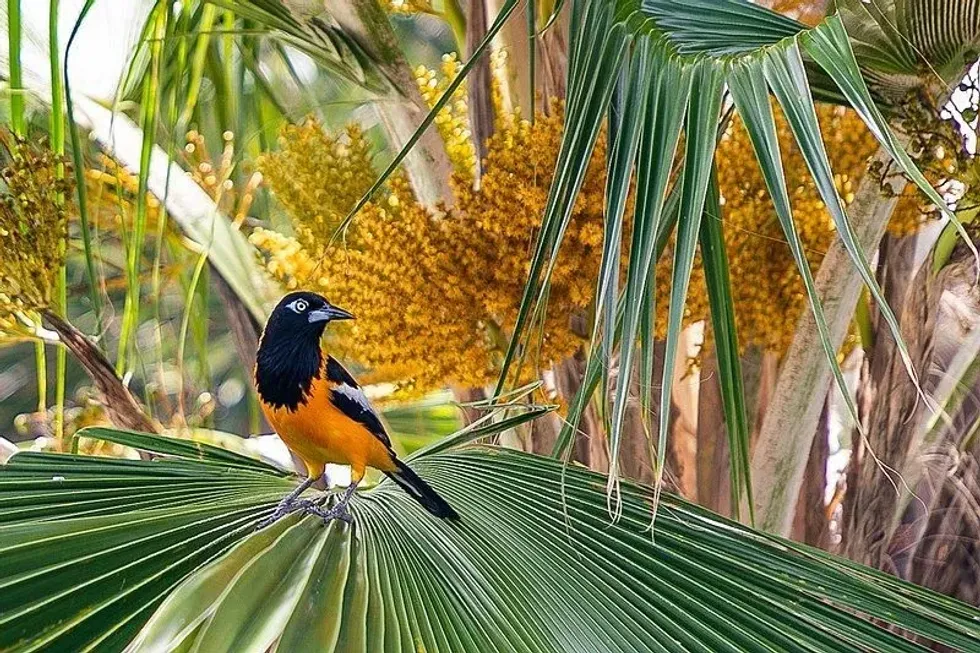The national bird of Venezuela, the Venezuelan troupial, is also known as Icterus icterus as its scientific name and is a common sight around the bird's natural habitat in South America, Colombia, Venezuela, and the Caribbean Islands of Aruba, Bonaire, Trinidad, and Curacao.
The bird was previously classified under the New World superspecies of troupial but was recently divided along with the orange-backed troupial and campo troupial. The head, neck, breast, and plumage are black in color with orange shaded feathers.
They also have distinct blue skin around their eyes.
As of now, the species does not face any harmful threats to its existence and is considered among the least concerned species. As for its name, the bird's name has been derived from the French word, 'troupiale', which stands for 'troop', in reference to how the birds prefer living in flocks.
On the other hand, the Latin name icterus is derived from the Greek word, 'ikteros', which stands for jaundice.
As a result of which, it was believed to cure jaundice in earlier days. However, it also has a much more common meaning depicting a yellow bird that was eventually adopted by the South American bird.
If you like reading about birds then we suggest you read about the guinea fowl and rufous hummingbird too!
Venezuelan Troupial Interesting Facts
What type of animal is a Venezuelan troupial?
It is a type of bird from the family of Icteridae under the genus Icterus.
What class of animal does a Venezuelan troupial belong to?
The bird belongs to the Aves class of the Icteridae family under the genus Icterus.
How many Venezuelan troupials are there in the world?
The population trend of the Icterus icterus species is stable with more than 10,000 mature individuals thriving in their natural habitats.
Where does a Venezuelan troupial live?
The orange and black national bird of Venezuela, Icterus icterus, loves woodlands with a dense and lush abundance of vegetation consisting of overgrown grasslands, fruit plantations, and scrub areas. They also adapt quite well to forest edges and fragmented habitats.
The birds can be seen up to 1,600 ft (487.68 m) in elevation while some of them fly in higher altitudes. They are commonly found in South America from northeastern Columbia all the way to northern Venezuela.
They are also a frequent sight in the Caribbean Islands of Aruba, Bonaire, Dominica, Curacao, Antigua, and Grenada. In places like Puerto Rico and the Virgin Islands, the birds were artificially introduced and have been thriving ever since.
What is a Venezuelan troupial's habitat?
Their habitat includes dry areas, scrubs, open savannas, woodlands, grassland plains, tropical grasslands, and lush forests. The birds forage their habitats for a wide variety of fruits, birds, insects, and eggs.
Who do Venezuelan troupials live with?
The Icterus icterus is generally found in pairs or alone but they do join small groups or flocks during the breeding season.
How long does a Venezuelan troupial live?
Even though the Venezuelan troupial (Icterus icterus) is the national bird of Venezuela, the life expectancy of the bird is still unknown.
How do they reproduce?
Their mating rituals usually include the males singing to attract their chosen partners and to convey their territorial status. The birds are monogamous in nature and reportedly stay together for a long time. The nesting season differs in every location but usually begins from March-September.
The orange birds are well known as nest pirates where they steal the nest of common Thornbirds or Great kiskadee's as they do not build their own.
The clutch size usually has an average of three to four eggs that are whitish-pink in color with dark spots. The incubation period lasts for 15-16 days and the newly born babies are taken care of by both the parents.
The hatchlings stay in the nest for 21-23 days after which, they travel and forage with their parents, and start stealing other birds' nests when they are of age.
What is their conservation status?
Due to the bird's national status and stable population rate, the species falls under the range of Least Concern according to the IUCN Red List.
Venezuelan Troupial Fun Facts
What do Venezuelan troupials look like?

The Venezuelan troupials are large orange birds with long tails and sharp bills, similar to orioles. The body is of bright orange color with a dash of black and brown feathers.
The head, neck, plumage, and breast are black while the front neck and lower portion of the bird are mixed with orange and black. A white streak runs in their wings surrounding the almost black area while the eyes are yellow with pale bright blue naked skin. The legs are gray-black and it has a wedge-shaped tail.
How cute are they?
Troupials have sharp eyes and a brightly colored set of feathers that sets them apart from other birds like orioles. The birds can definitely be put on the cuteness radar with their bright orange plumage and distinct calls.
How do they communicate?
The troupials are quite loud in nature and communicate through their call and song. Their song usually consists of two to three distinct notes repeated after continuous phrases.
This method of communication can be compared with that of golden orioles who use similar songs and calls. The same can be heard throughout the early morning hours in their natural habitats.
How big is a Venezuelan troupial?
The bird can grow up to a length of 9-10 in (22.86-25.4 cm), slightly bigger than a fox sparrow.
How fast can a Venezuelan troupial move?
Troupials are known to fly and move similar to other species of orioles, but their exact speed remains unknown.
How much does a Venezuelan troupial weigh?
A Venezuelan troupial weighs about 2-2.3 oz (56.69-65.20 g).
What are the male and female names of the species?
There are no sex-specific names for Venezuelan troupials.
What would you call a baby Venezuelan troupial?
Baby troupials can be referred to as hatchlings or chicks.
What do they eat?
Venezuelan troupials (Icterus icterus) are omnivorous birds whose usual food habits consist of insects, berries, seeds, fruit, and nectar. Other times, they also eat young nestlings and eggs of other smaller breeds whenever they get the chance.
On the contrary, their nestlings are often threatened by botflies whereas adult birds can be killed by larger predators such as falcons and common nighthawks.
Are they dangerous?
The fruit-loving Venezuelan troupials are usually shy and mind their own business but when it comes to territorial issues, they are quite loud and aggressive in nature. This can lead to dangerous situations if the scenario turns drastic for they tend to chase away intruders vigorously away from their nests and are very loud in the process.
Would they make a good pet?
As mentioned before, the Venezuelan troupial is the national bird of Venezuela and as such, harming the bird or keeping them as pets is illegal.
They do make excellent companions as pets for their beautiful voice, call, and striking features but if you're wondering about keeping one as a pet then we suggest you not to, as all birds in this world deserve to be free and happy.
Did you know...
Troupials are known to be territorial and hence exhibit aggressive behavior when defending their nest range during the breeding season. They are also known as bugle birds due to their sharp, piercing, yet melodious voice which makes them popular cage birds.
They do not build their own nests but steal the nests of other birds and use them throughout the breeding season.
The Venezuelan troupial as a national bird
As previously mentioned, the Venezuelan troupial is the official national bird of Venezuela. The reason for this is not just because of the bright color coordination and wide range of habitats in the country but to showcase the importance of the amazing bird diversity in South America.
It has been reported that more than 1,300 species of birds thrive in the country, as a result of which it is a popular destination for many birdwatchers and environmentalists.
The troupial species
A total of three extended species of troupials are present in the world including the Venezuelan troupial, Campo troupial, and the orange-backed troupial. There was another in the list but the same had been extinct in the late quaternary period, called the Talara troupial.
All of the birds were former members of the New World orioles found in central-south and north America. However, the same had been divided from the group recently and recognized individually as a different species since there were no records of the birds interbreeding.
Here at Kidadl, we have carefully created lots of interesting family-friendly animal facts for everyone to discover! Learn more about some other birds from our great green macaw facts and hooded oriole facts for kids.
You can even occupy yourself at home by coloring in one of our free printable Venezuelan Troupial birds coloring pages.
Main image by Aatu Dorochenko.
Second image by Paolo Costa Baldi.









